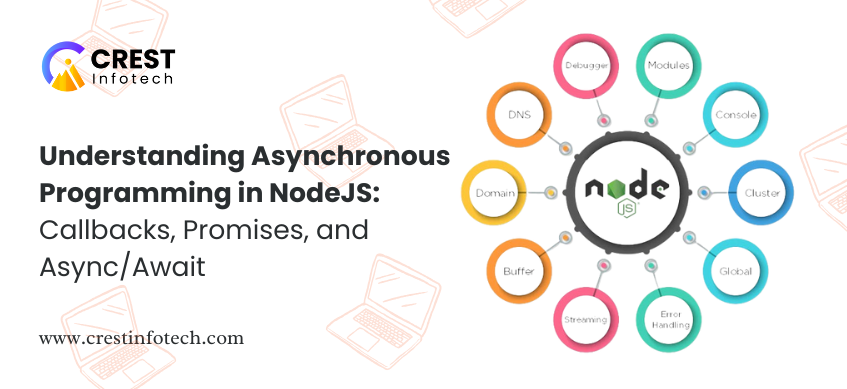Asynchronous programming is a core feature of Node.js, which allows developers to write non-blocking, scalable code. This is particularly important in server-side applications where I/O operations, such as reading from a database or making network requests, can be time-consuming. Node.js achieves this through its event-driven, non-blocking I/O model.
In this article, we’ll explore the three primary mechanisms for handling asynchronous operations in Node.js: callbacks, promises, and async/await. By understanding these patterns, you’ll be able to write more efficient, readable, and maintainable asynchronous code.
What is Asynchronous Programming?
In synchronous programming, tasks are executed one after the other. Each task must complete before the next one can begin. While this model is easy to understand, it can lead to performance issues in web applications. For example, if a request involves reading data from a database, the server would be blocked from handling other requests until that database read is complete.
Asynchronous programming allows tasks to be executed independently. While one task is waiting for a response (like reading from a database or an API), other tasks can be executed. When the response arrives, the task is resumed. This non-blocking approach significantly improves performance in I/O-heavy applications.
Callbacks: The Foundation of Asynchronous Code
A callback is a function passed as an argument to another function. Once the asynchronous task is complete, the callback function is executed with the result.
Example of a Callback
Here’s an example of a callback in Node.js for reading a file:
const fs = require('fs');
fs.readFile('example.txt', 'utf8', (err, data) => {
if (err) {
console.error('Error reading the file', err);
return;
}
console.log('File content:', data);
});
In this example:
fs.readFileis an asynchronous function that reads the content of a file.- The callback function is executed once the file is read, either handling an error (
err) or logging the file content (data).
While callbacks work well for simple tasks, they can quickly lead to complex and difficult-to-maintain code when dealing with multiple asynchronous operations. This is known as callback hell.
Callback Hell
When multiple asynchronous operations are nested, you end up with deeply nested code, making it harder to read and maintain. Here’s an example:
fs.readFile('example1.txt', 'utf8', (err, data1) => {
if (err) return console.error(err);
fs.readFile('example2.txt', 'utf8', (err, data2) => {
if (err) return console.error(err);
fs.readFile('example3.txt', 'utf8', (err, data3) => {
if (err) return console.error(err);
console.log(data1, data2, data3);
});
});
});
This is where promises come in to help flatten asynchronous operations.
Promises: A Step Forward
A promise is an object that represents the eventual completion (or failure) of an asynchronous operation and its resulting value. It allows chaining of asynchronous operations, improving readability.
Example of a Promise
Here’s the same file reading example using promises:
const fs = require('fs').promises;
fs.readFile('example.txt', 'utf8')
.then((data) => {
console.log('File content:', data);
})
.catch((err) => {
console.error('Error reading the file', err);
});
In this example:
fs.promises.readFilereturns a promise that resolves when the file is successfully read or rejects if an error occurs.- The
.then()method is used to handle the resolved promise and access the file content. - The
.catch()method is used to handle any errors.
Chaining Promises
Promises can be chained to avoid callback hell. Here’s an example:
const fs = require('fs').promises;
fs.readFile('example1.txt', 'utf8')
.then((data1) => {
console.log('First file:', data1);
return fs.readFile('example2.txt', 'utf8');
})
.then((data2) => {
console.log('Second file:', data2);
return fs.readFile('example3.txt', 'utf8');
})
.then((data3) => {
console.log('Third file:', data3);
})
.catch((err) => {
console.error('Error reading a file', err);
});
Each .then() call returns a new promise, allowing you to chain operations in a readable way. The .catch() method at the end handles any errors that occur in any of the promises in the chain.
Async/Await: Simplifying Promises
Introduced in ES2017, async/await is built on top of promises and provides an even cleaner way to write asynchronous code. It allows you to write asynchronous code that looks synchronous, which makes it easier to read and maintain.
Async/Await Syntax
- The
asynckeyword is used to define an asynchronous function. - The
awaitkeyword is used to pause the execution of anasyncfunction until a promise is resolved.
Example of Async/Await
Here’s the same file reading example using async/await:
const fs = require('fs').promises;
async function readFiles() {
try {
const data1 = await fs.readFile('example1.txt', 'utf8');
const data2 = await fs.readFile('example2.txt', 'utf8');
const data3 = await fs.readFile('example3.txt', 'utf8');
console.log(data1, data2, data3);
} catch (err) {
console.error('Error reading a file', err);
}
}
readFiles();
How Async/Await Works
- The
readFilesfunction is marked with theasynckeyword, making it an asynchronous function. - Inside the function, each
awaitstatement pauses the execution of the function until the promise resolves. This makes the code look more like traditional synchronous code. - Errors are handled using a
try/catchblock, which is easier to manage than multiple.catch()blocks in promise chaining.
Benefits of Async/Await
- Readability: The code reads top to bottom, much like synchronous code, making it easier to follow.
- Error Handling:
try/catchblocks are simpler and more intuitive than handling errors with.catch()for each promise. - Sequential and Parallel Execution: Async/await provides more control over how promises are handled, whether sequentially or in parallel.
Sequential vs. Parallel Execution
In the example above, each file read waits for the previous one to complete, making the process sequential. If you want to read all files in parallel (which is often more efficient), you can use Promise.all:
const fs = require('fs').promises;
async function readFiles() {
try {
const [data1, data2, data3] = await Promise.all([
fs.readFile('example1.txt', 'utf8'),
fs.readFile('example2.txt', 'utf8'),
fs.readFile('example3.txt', 'utf8')
]);
console.log(data1, data2, data3);
} catch (err) {
console.error('Error reading files', err);
}
}
readFiles();
Conclusion
Asynchronous programming is fundamental to writing scalable applications in Node.js. Understanding how to handle asynchronous operations using callbacks, promises, and async/await is essential for modern JavaScript development.
- Callbacks provide a basic approach to handle asynchronous tasks but can lead to complex, hard-to-maintain code (callback hell).
- Promises offer a more elegant solution by enabling chaining and better error handling.
- Async/Await builds on top of promises, offering cleaner, more readable code while still providing all the power of asynchronous programming.
By mastering these techniques, you’ll be able to write efficient and scalable Node.js applications that handle multiple asynchronous operations with ease.



